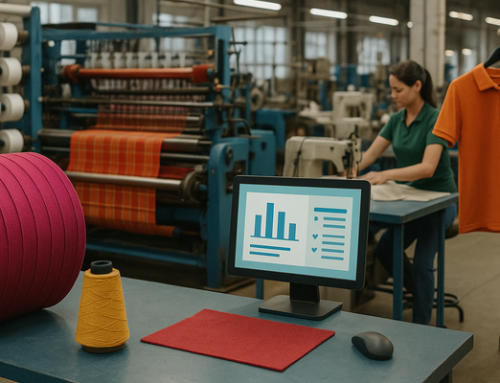Textile Recycling: How to Combat Clothing Waste
Dear readers of the Datatex blog,
In today’s post, we’ll be delving into the topic of textile waste recycling. This subject is closely linked to our previous two topics, especially our exploration of ERP and Sustainability. It is an extremely important and very relevant topic, so it should come as no surprise that we are dedicating so much space to it.
Recycling of apparel concerns all of us globally, but the entire concept of recycling starts from each individual, society, or state separately.
We should all remember that we share this planet; it’s not solely ours. We’ve been entrusted with it for the duration of our lifetime, with the expectation that we care for it, ensuring that future generations can also benefit from its abundant resources.
While the growing interest in this topic is encouraging, what’s crucial is raising collective awareness about the broader benefits that come from managing all forms of waste, including textiles. Through ongoing education—something at the core of our blog—we aim to contribute to this important conversation.
As the fashion industry continues to grow, so does the amount of clothing and textile waste that ends up in landfills. To protect our environment and promote a more circular economy, recycling textiles has become crucial in reducing the impact of this waste. In this article, we will explore what textile recycling is, how to recycle textiles, and the overall impact it has on our planet. Let us first understand what are we dealing with.
Understanding Textile Recycling
In today’s world, where clothing waste is a pressing issue, textile recycling plays a vital role in reducing environmental impact. By understanding the concept of textile recycling and its importance, we can make informed decisions to combat clothing waste and contribute to a more sustainable future.
Now, understanding the term “recycling” is crucial, because it has a wide range of meanings. In fact, there are two distinct types of recycling: closed-loop recycling and open-loop recycling.
Closed-loop recycling is our ideal goal. For instance, when an aluminum can is recycled into a new aluminum can, it exemplifies closed-loop recycling. This system effectively closes the loop on resources, actively diminishing the need for new, virgin resources.
On the other hand, open-loop recycling is more common in current practices. This process involves converting one item or material into a different one (ex. plastic to footwear). While open-loop recycling helps divert resources from landfills, it doesn’t necessarily decrease the demand for new, virgin resources.
The Benefits of Recycling Textiles
One of the significant advantages of textile recycling is the diversion of textiles from landfills. Textiles being thrown into landfills contribute to the growing solid waste problem, taking up valuable space and causing environmental harm. Through recycling, we can significantly reduce the amount of textile waste ending up in landfills, minimizing their impact on our ecosystem.
Recycling textiles offers numerous benefits that go beyond waste reduction. As we saw, when textile waste is recycled, it can be transformed into new materials or repurposed for various industries.
This not only reduces the demand for raw materials but also saves energy and reduces greenhouse gas emissions compared to producing new textiles.
By understanding the importance of textile recycling and exploring the options available, we can actively contribute to reducing clothing waste and preserving our environment. Let’s embrace textile recycling and make a positive impact on our planet.
The Role of Recycling Companies and Textile Collection
Recycling companies play a crucial role in textile recycling by providing the infrastructure and facilities to process and transform textile waste. They collect textiles from various sources, such as clothing donation centers and take-back programs, ensuring that these materials are diverted from landfills and given a new life. Textile collection initiatives make it easier for individuals to participate in textile recycling and contribute to the circular economy.
How to Recycle Textiles?
Recycling textiles is an essential step in reducing clothing waste and promoting sustainability. By following a few simple steps, you can contribute to a greener future. Here’s how you can recycle your old clothes and other textile items:
Table: Textile Recycling Options
| Recycling Option | Description |
|---|---|
| Donating to Clothing Recycling Companies | Donating used clothing and textiles to dedicated recycling companies ensures that they are properly handled and recycled into new materials. |
| Utilizing Take-Back Programs | Many clothing brands offer take-back programs where customers can return their old clothes for recycling, often providing incentives or discounts for new purchases. |
| Donating to Clothing Donation Centers | Clothing donation centers accept gently used or unwanted clothing, ensuring that these items are either reused or recycled. |
Properly prepare your old clothes and textile items
Before recycling your old clothes, it’s important to properly prepare them. Start by sorting through your wardrobe and identifying items that are no longer in use or in good condition. Remove any accessories or non-textile elements, such as buttons or zippers, as they may interfere with the recycling process.
Next, make sure to clean your textiles before recycling them. Laundering your clothes ensures that they are free from dirt and stains, making them easier to recycle. Remember to follow the care instructions on the garment labels to preserve their quality during the washing process.
Donate your clothing to textile recycling companies or utilize take-back programs
If your old clothes are still in good condition, consider donating them to textile recycling companies or utilizing take-back programs offered by brands or retailers. Many companies have initiatives that allow you to mail in your unwanted clothing or drop them off at designated collection points. These programs ensure that your clothing is donated to a textile recycler or given a new life through resale or repurposing.
Alternatively, you can participate in take-back bag programs provided by certain retailers. These programs allow you to fill a designated bag with your unwanted items and return it to the retailer for recycling. This convenient option makes recycling clothes even easier and more accessible.
Utilize dedicated recycling centers for textile recycling
Dedicated recycling centers are another option for recycling your textiles. These facilities specialize in processing and recycling used clothes and other textile items. Simply drop off your items at a nearby recycling center, and they will be properly sorted and processed for recycling.
When recycling textiles, it’s important to identify the suitable items for recycling. While many textile recycling companies accept a wide range of textiles, some may have specific requirements or restrictions. Avoid including items that are heavily damaged or contaminated, as they may not be suitable for recycling.
Textiles that are donated to a textile recycler undergo a sorting process. They are separated by color and quality to ensure that they are properly recycled or repurposed. High-quality clothing items may be resold, while textiles that cannot be reused are typically broken down into fibers and used to create new textile products.
Textile Recycling Tips
By recycling your textiles, you can make a positive impact on the environment and contribute to the reduction of clothing waste. Take the initiative to recycle your old clothes and other textile items, and together, we can create a more sustainable future. Here are some useful tips:
Sort through your wardrobe to identify unwanted textiles
Do your local research by typing “Where to recycle clothes in….”
Clean your textiles before recycling them
Remove non-textile elements like buttons or zippers
Donate to textile recycling companies or use take-back programs
Utilize dedicated recycling centers for textile recycling
Avoid including heavily damaged or contaminated items
Connecting Recycling to Technology: The Role of Textile ERP Solutions
Recycling is just one piece of the sustainability puzzle. For textile and apparel manufacturers, ERP solutions like Datatex NOW ERP offer a comprehensive way to reduce waste and improve efficiency throughout the supply chain. By enabling real-time tracking of materials, monitoring production processes, and optimizing resource usage, ERP systems help businesses minimize waste at every stage—from raw material acquisition to final product distribution.
For more on how ERP supports sustainability, check out our articles on ERP and Sustainability and the role of ERP in textile supply chains. Together, these technologies and practices empower manufacturers to align with a circular economy, contributing to a greener planet while maintaining profitability.
Your effort matters
In previous blog posts, we’ve seen how ERP solutions help textile and apparel manufacturers in their pursuit of sustainability and reducing negative environmental impact .
In this post, we’ve introduced solutions that each of us as individuals and citizens can implement to reduce pollution through the practice of recycling. There’s much we can do as individuals, as every change begins with each of us.




